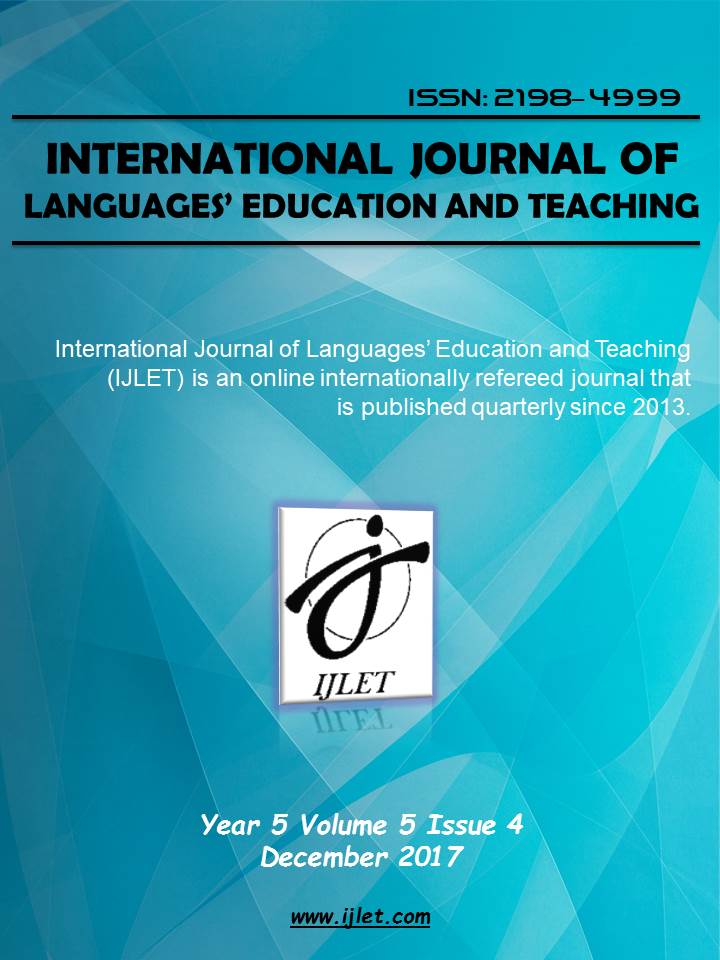Assessment of Written Expression Skills of University Students in Terms of Text Completion Technique
Author :
Abstract
Keywords
Abstract
Writing is to transfer the visualised ideas on the paper. Writing, one of the language skills, is a significant tool of communication which provides the permanency of information conveying emotions and thoughts. Since writing has both cognitive and physical aspects, it makes writing the hardest and the latest language skill to improve. The studies show that writing activity is the most difficult skill students have difficulty. In higher education, in order to improve writing skills of students and give basic information and skills about writing skills written expression, composition and writing education lessons are taught both in the department of Turkish Language and Literature and in the departments of Turkish Language in the Faculties of Education. One of the aims of these lessons is to teach students written expression techniques together with the purposes and practices. One of the written expression techniques is text completion skill that improves student’s creativity and enhances her/his imaginary world. The purpose of this study is to assess students’ skills of using text completion technique with reference to the writing studies of students in higher education. the sample of the study consists of 85 college students studying in the department of Turkish Language and Literature in Gümüşhane University in 2016-2017 academic year. The data of the study were obtained from the written expression studies of the students. The introduction part of the article ‘On Reading’ by F. Bacon was given to the students and they were required to complete the text. ‘Text Completion Rating Scale in Writing Expression’ was developed to assess the data of the study by taking opinions of lecturers and Turkish education experts. The data of the study were presented with percentage and frequency rates. At the end of the study, it was concluded that students had weakness in some skills such as writing an effective body part about the topic given in the text, narrating the subject matter in logical coherence, segueing properly among paragraphs, comprehending the main theme and writing connective and impressive conclusion.
Keywords
- Arıcı, A.F. (2008). Üniversite Öğrencilerinin Yazılı Anlatım Hataları, Uludağ Üniversitesi Eğitim Fakültesi Dergisi xxı (2),, 209-220.
- Bağcı, H. (2007). Türkçe Öğretmeni Adaylarının Yazılı Anlatıma ve Yazılı Anlatım Derslerine Yönelik Tutumlarının Değerlendirilmesi, TÜBAR-XXI, 29-61.
- Coşkun, E. (2005). İlköğretim Öğrencilerinin Öyküleyici Anlatımlarında Bağdaşıklık, Tutarlılık Ve Metin Elementleri (Yayımlanmamış doktora tezi), Gazi Üniversitesi Eğitim Bilimleri Enstitüsü: Ankara.
- Coşkun, E.,Tiryaki, E. N. (2013). Writing Skills of University Students on Argumentative Text, Hacettepe University. Journal of Education) 28(2), 102-115
- Dumaine, D.(2004). Leadership in Writing, T+D, 58, pp. 52-54.
- Fink-Chorzempa, B., Graham, S., ve Harris, K. R. (2005). What Can I Do to Help Young Children Who Struggle With Writing? Teaching Exceptional Children, 37, 64-66.
- Güzel, Abdurrahman: (1987), “Türk Dili ve Edebiyatı Öğretmenliği Programları” Öğretmen Yetiştiren Yüksek Öğretim Kurumlarının Dünü- Bugünü- Geleceği Sempozyumu. (8-11 Haziran). Gazi .Üniversitesi Yay.. 436-437, Ankara.
- Graham, S. ve Perin, D.(2007). Writing Next: Effective Strategies to Improve Writing of
- İşeri, K. Ünal, E. (2012). Türkçe Öğretmen Adaylarının Yazma Kaygı Durumlarının Çeşitli Değişkenler Açısından İncelenmesi Mersin University Journal of the Faculty of Education, Vol. 8, Issue 2, pp.67-76.
- Kaplan, M. (1972) Kompozisyon“, Hisar Dergisi. (101) Mayıs. İstanbul.
- Kavcar, Cahit: (1998), “Türkçe Eğitimi ve Sorunları” Ankara Üniversitesi TÖMER Dil Dergisi. pp. 5-17, Ankara.
- Madge, J. (1965). The Tools of Science An Analytical Description of Social Scince Techniques. Anchor Books Doubleday and Comp.
- Marshall, J. (1994), Anadili ve Yazın Öğretimi. (Çev: Cahit Külebi), Başak Yay., Ankara.
- Getting Introductions. Journal of Adolescent & Adult Literacy, 50, 2006: 190-193.
- Sever, S. (1998), Dil ve İletişim, Ankara Üniversitesi Eğit. Bil. Fak. Dergisi. C:31, Ankara, s.51-66
- Şişman, M. (1999), Öğretmenlik Mesleğine Giriş, Pegem A Yayıncılık, Ankara.
- Ungan, S. ve Arıcı, A. F. (2006).Yazılı Anlatım Becerileri Açısından İngiliz Dili ve Edebiyatı Öğrencileri ile Türkçe Eğitimi Bölümü Öğrencilerinin Karşılaştırılması, XV. Ulusal Eğitim Bilimleri Kongresi Bildirisi, Muğla.
- Tural, S. K. (1992), Sorulara Cevaplarla Kültür, Edebiyat, Dil, Ankara: Ecdad Yayınevi,
- Yalçın, A. (2002). Türkçe Öğretim Yöntemleri-Yeni Yaklaşımlar. Ankara: Akçağ Yay.
- Yıldız, C., Okur, A., Arı G. ve Yılmaz, Y. (2006). Yazma Öğretimi. Yeni Öğretim Programına Göre Kuramdan Uygulamaya Türkçe Öğretimi (Ed. Cemal Yıldız). Ankara: PegemA Yayıncılık. 203276.
